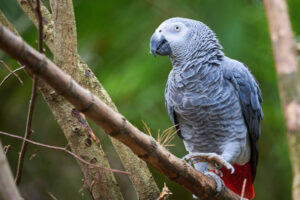Have YOU been making any of these common dog training mistakes?
Are you a pet parent embarking on the journey of training your furry friend? While it’s an exciting endeavor, it can be challenging. In the world of canine coaching, there are dog training mistakes that even the most well-intentioned owners can struggle with.
From inconsistent routines to mixed signals, these blunders can hinder your pup’s progress and frustrate both of you. But fear not!
With some knowledge and guidance from The Geeky Gecko, you can avoid these pitfalls and pave the way for successful dog training sessions. Let’s explore the 8 most common dog training mistakes, and we’ll provide practical tips on how to avoid them.
Grab your pup, and let’s unleash its full potential!

Dog training mistake: Working when you’re grumpy
Never train your pup when you’re in a bad mood. Our patience tends to wear thin when we’re frustrated, and we’re more likely to get angry at our dog for not getting things right on the first try.
If you’ve had a bad day, snuggle or play fetch with your dog and forget about training for a bit. It’s therapeutic for both of you! Dog training has many nuances, but by avoiding these common mistakes, you’re setting your dog up for success, making the process go faster.
Dog training mistake: Accidentally teaching bad habits
Chances are, you probably don’t even know you’re doing it. But just as you can reinforce fearful behavior, you can reinforce bad habits as well. This includes habits like jumping, pawing, whining, or begging. Usually, it’s not as dangerous as it is annoying.
But most complain about it without realizing they’re inadvertently training their pooch to behave that way all along. For example, if you pet a dog that jumps, you’re rewarding the jumping and teaching it to jump for attention in the future.
The same goes for dogs who bark or whine to get attention. And if you give in to a begging dog at the dinner table, you can be sure he’ll make begging a habit in the future!
Dog training mistake: Cue nagging
One of the most significant dog training mistakes is cue nagging. This is when your dog doesn’t react to a cue, so you keep repeating it over and over again. This frequently happens with the word “come.” You say it. Your dog ignores you, so you keep saying it.
Soon, your dog doesn’t even pay attention until you’ve said the word ten times. By repeating the cue, you’ve taught your adorable pup that he doesn’t have to respond right away. And the cue is now “come, come, come.” It’s crucial to say the cue simply once.
If your dog is distracted, and you don’t think he’s listening, don’t say it. Instead, see if you can get his attention first. This will help you avoid cue nagging and train your dog to respond to a single word every time.
Dog training mistake: Leaving food your dog can reach
Your phone begins to ring, and you dash off for a second, only to come back and find your dog gobbling what you left on the kitchen counter. Once your dog realizes that he can score yummy snacks this way, they’re more likely to keep this up.
They’ll simply keep counter-surfing because they know there’s good stuff up there. And while we’re on this topic, be aware of the foods that can kill your canine, not just chocolate but also onions, macadamia nuts, avocado, raisins, and yeast.
You should train your dog not to eat anything off the counter or table, but be especially attentive with dogs you haven’t trained yet.

Dog training mistake: Failing to practice in-between sessions
Not practicing in between your training sessions is also a big oversight owners make. As we all know: Practice makes perfect, and it definitely applies to dog training, as well.
And if you attend a class with your pooch once a week, that’s not enough time to create a well-behaved dog. Make sure you practice daily but for brief periods. Dogs have the psyche of a human toddler, and just like toddlers, their attention spans can be brief.
For most puppies, you’ll have better success with 5-to-10-minute sessions. And be sure to have the right training supplies and training treats at home.
Dog training mistake: Punishing your pup after following commands
Now, hear us out on this one. We know you’re thinking: “I would never do this!” But you just might be preventing your dog from following your commands. Let’s take “come” or “here” for instance. Do you call your dog at the park, only to instantly put the leash on and leave?
Do you tell them to come and put them in the bathtub? Or do you tell your furry pal, “Here!” only to put him directly in his crate? It’s kind of like being called to the principal’s office. They think they’re being disciplined and won’t want to come to you.
Here’s what you can do: Train your dog indoors in the beginning to come to you and offer a treat. And don’t wait for him to make it to you before you begin praising. Do it when he starts making his way towards you.
When he approaches, show him that’s exactly what you want him to do. Teach them that it’s something that’s fun and rewarding, experts suggest. Don’t use the command outside until your dog is 100% trustworthy indoors and you’ve practiced a bit outside.
You can’t expect your dog to come the first time you issue the command outdoors. You must practice in that environment using positive reinforcement.
Dog training mistake: Enabling chewing
Chewing is typical behavior for puppies. But give them a different outlet early on so they don’t chew slippers or other expensive items! Do you leave high-value items lying around, knowing you have an aggressive chewer in your home?
When dogs are puppies, they don’t know any better. But if you have an excessively aggressive chewer, you may want to ask yourself why. The canine likely needs more exercise or something to stimulate them away from chewing.
You should look into the anxiety that’s causing them to do this. You can also give them something else to chew like bully sticks. If you don’t address or redirect the issue, dogs will almost always find something to munch on, whether it be rugs, shoes, or even chair legs.

Dog training mistake: Not teaching your dog leash etiquette
It’s happened to the best of us. Our dogs have pulled on the leash, resulting in them walking us rather than the other way around! Some individuals wait too long to take their dog out on a leash.
If you’re worried about exposing a young puppy to illnesses, you can always walk them on a leash indoors to get them accustomed to a leash at an early age. If you begin too late, they’ll start pulling and jumping around when you finally get that leash on them.
When you begin early enough, you’re teaching them that a leash is going to be a normal part of their life. If you wait until they’re four months old and take them out for the first time with a leash, they’re likely to be confused.
And if your lovable pooch pulls or strains at the leash, experts suggest you keep a very short leash and keep your dog’s attention concentrated on you.
Have you ever made any of these dog training mistakes? Be sure to share your experiences with our readers in the comments section below. And if you found this article useful, we highly recommend you also check out: 16 Tell-Tale Symptoms You Should NEVER Ignore in Your Dog













One Response
Your dog training methods are spot on.
I’m aged senior who has trained dogs all of my life and specialized in problems.
Thank you so very much for all of your valued training ideas that are proven